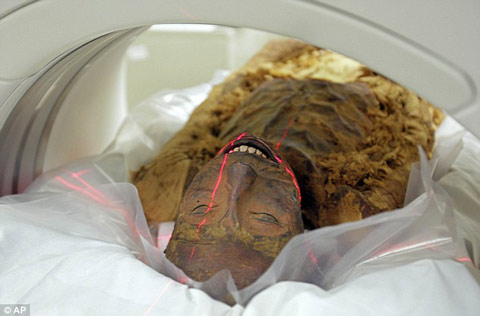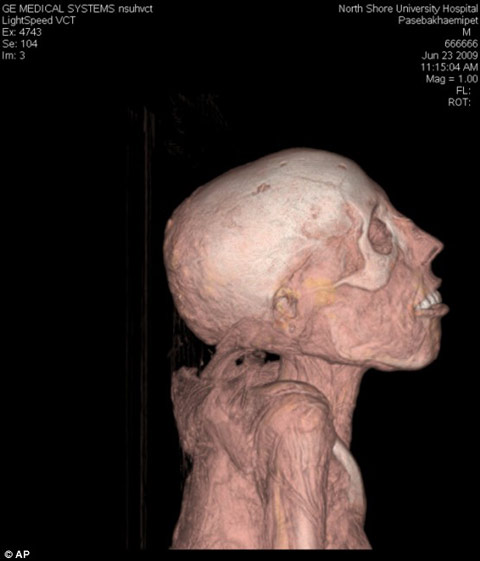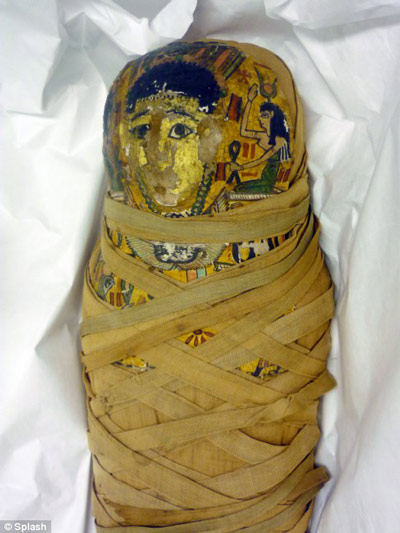CT scan to find the sex of the mummy
The identity, the cause of death and the unique type of burial of mummies has always been a mystery for centuries. Several scientists from many countries recently conducted 'dissection' of the body under the thick fabric of two Egyptian mummies.
The photos document the process of scientists using modern medical technology, showing very small details about the characteristics of identifying these two bodies and how they were preserved after 2,000 years.

CT scanner technology helps scientists discover many mysteries about mummies.
The photo was taken at North Shore University Hospital, Manhasset, New York, USA, capturing a mummy image of a prince, when going through a CT scanner. This is one of four mummies belonging to the Brooklyn, New York Museum, ranging in age from 1,700 to 3,000 years, obtained by using the technology.

Mummy of a Prince aged 1,700 - 3,000 years.
Meanwhile, a photo of a similar scanner from a specialist clinic in central Sydney solved the question of identifying a mummy owned by Sydney's Nicholson Museum, which made archaeologists 'headache' during the last 150 years.
This mummy was originally thought to be the rest of a girl, but recent CT scans confirm that this is a male body. And a piece of papyrus hidden in it revealed he was called Horus.

Previously, scientists thought that the Horus mummy was a girl.
Michael Turner, the manager of Nicholson Museum, said: 'These photos are amazing. We discovered a lot more than 150 years ago. Horus is 100% male and his piece of paper has been discovered since a few years ago but there is still gender confusion. We still cannot say how he died but with modern technology it can be discovered in the next few years. '
Dr Margaret Stewart and her team at the Sydney specialty center, said: 'This is the first time we have used scanner technology for a mummy. I was very impressed with the nearly intact state of how to preserve this body. The bones are almost in the same state as when they died. It is even possible to see the tiny bone in the middle ear, which is the smallest part of the human body. I am very impressed by the ability of ancient Egyptians to embalm the body, even now to do so is quite a difficult thing '.


The outer part of Horus mummy compared to the detailed image inside was taken with a scanner.
According to Janet Davey, researcher on Egypt: 'These photos are amazing. They help scientists study mummies without touching or changing states. Horus is a good example of the effectiveness of this technology. He certainly came from a wealthy family so he could use this embalming method when he died. I hope more mummies will be studied under this method. '
According to the study, this mummy appeared from the 2nd century AD from Thebes region, a city on the Nile River, about more than 800 km south of the Mediterranean. After death, Horus's body was washed and wiped with aromatic oil. The internal organs of the body are removed from the body, instead of salt to dry. After that, the body is tightly wrapped with cloth.
- The thousand-year-old cat mummy has 5 legs and 3 tails
- New scan technology that reads information on Egyptian embalmed paper
- Revealing the mysterious mummy of men in female attire
- Discover the mummy of cats when repairing the house
- A thousand-year-old gold mummy like the one who lives in China
- Discover the mystery of the famous mummy
- World famous mummies
- 10 mummies contain many mysteries
- New discovery about 2300-year-old Egyptian mummy
- Find strange wrap in Egyptian mummies
- The mysterious 2,000-year-old mummy in China still has blood
- Close up of 800-year-old
 Discovered an ancient centipede fossil 99 million years old
Discovered an ancient centipede fossil 99 million years old Discovered bat-like dinosaurs in China
Discovered bat-like dinosaurs in China Discovered a 200-year-old bronze cannon of the coast
Discovered a 200-year-old bronze cannon of the coast Discover 305 million-year-old spider fossils
Discover 305 million-year-old spider fossils